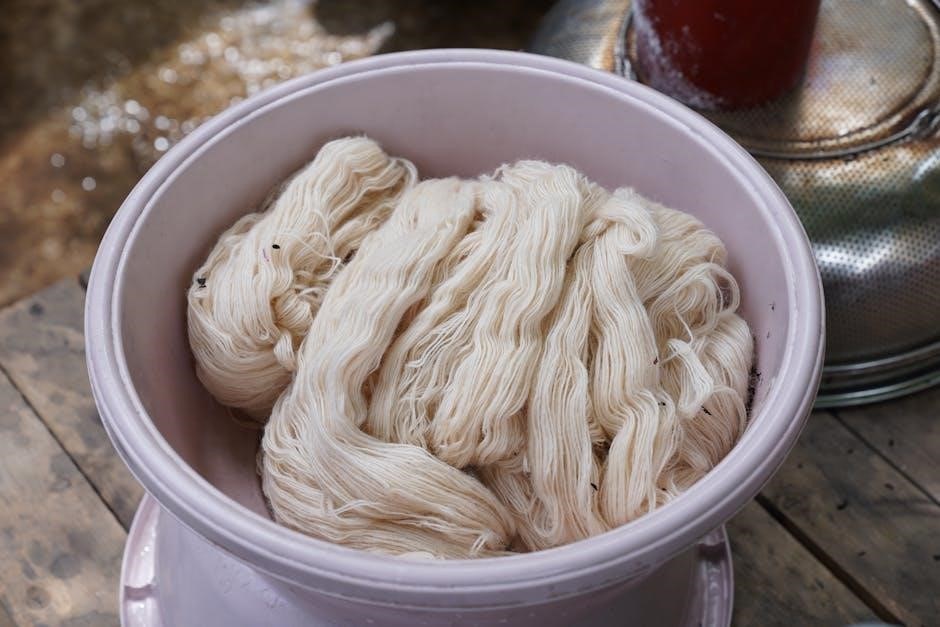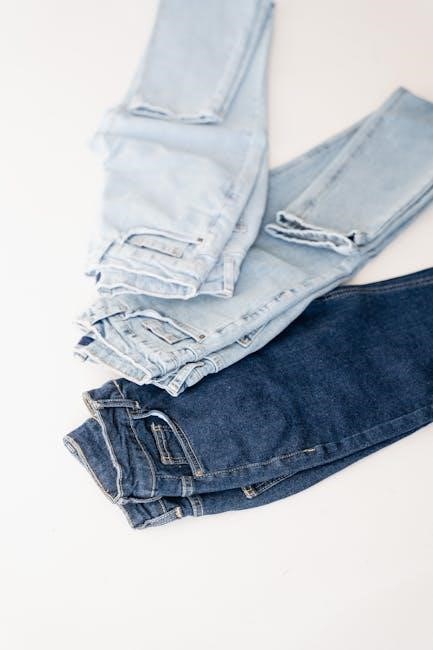wash instructions for 100 cotton
Love your 100% cotton clothes? Don't ruin them! Our simple wash instructions cover everything from temperature to drying – keep your favorites comfy & new.
Cotton’s versatility is renowned, yet proper wash instructions are crucial for maintaining its quality and longevity. Understanding these guidelines ensures comfort and durability.
Why Proper Wash Instructions Matter for Cotton
Ignoring proper wash instructions can significantly diminish the lifespan and appearance of 100% cotton garments. Cotton fibers, while durable, are susceptible to shrinkage, fading, and losing their shape with incorrect laundering. Overwashing, especially with hot water, weakens the fibers, leading to premature wear and tear.
Furthermore, using harsh detergents or excessive heat during drying can cause irreversible damage. Following recommended guidelines preserves the fabric’s integrity, maintains vibrant colors, and ensures continued comfort. Proper care isn’t just about cleanliness; it’s an investment in the longevity of your cotton clothing, saving you money and reducing textile waste.
Understanding Cotton Fiber Characteristics
Cotton fibers are primarily composed of cellulose, a natural polymer that gives the fabric its strength and absorbency. However, this structure also makes cotton prone to shrinking when exposed to heat and moisture. The fibers swell and contract, altering the garment’s dimensions.
Additionally, cotton’s porous nature means it readily absorbs dyes, making it susceptible to color fading over time, especially with harsh detergents or prolonged sun exposure. Understanding these characteristics is key to selecting appropriate washing methods and products, ensuring gentle care and preserving the fabric’s quality.

Decoding Laundry Symbols for Cotton
Laundry symbols offer concise guidance for cotton care, indicating appropriate wash temperatures, drying methods, and ironing settings for optimal fabric preservation.
Common Laundry Symbols Explained
Decoding those mysterious symbols on clothing tags is essential! A wash tub signifies washing; if it has a number inside, that’s the maximum water temperature in Celsius. A hand in the tub means hand wash only. A triangle indicates bleaching – an empty triangle means safe to bleach, while an ‘X’ through it prohibits bleaching. A square signifies drying; a circle inside denotes tumble drying, with dots indicating heat level. An ‘X’ through the square means do not tumble dry. An iron symbol shows ironing temperature, with dots for heat settings. Finally, a circle within a square signifies professional dry cleaning.
Temperature Indicators for Cotton Wash
Generally, 100% cotton thrives in moderate temperatures. Warm water (around 30-40°C or 86-104°F) is ideal for most colored cotton items, preventing fading and shrinking. For whites, hotter water (up to 60°C or 140°F) can enhance brightness, but check the garment label. Cold water is best for delicate cotton or to minimize shrinkage. Avoid extremely high temperatures, as they can damage fibers. Always prioritize the garment’s care label, as specific dyes or finishes may require cooler washes. Consistent moderate temperatures prolong cotton’s lifespan.

Washing Machine Settings for 100% Cotton
Utilize your washing machine’s settings wisely for optimal cotton care. Selecting the appropriate cycle and temperature preserves fabric integrity and color vibrancy.
Selecting the Right Wash Cycle
Choosing the correct wash cycle is paramount when cleaning 100% cotton items. A “normal” or “regular” cycle generally works best for everyday cotton clothing, providing a balance between cleaning power and fabric preservation. For heavier cotton items like denim or canvas, a “heavy-duty” cycle offers more robust cleaning.
Delicate cottons, such as lightweight shirts or blends, benefit from a “delicate” or “gentle” cycle, minimizing agitation. Avoid using harsh cycles like “permanent press” unless specifically recommended, as they can damage cotton fibers. Always check garment care labels for specific instructions, as some items may require specialized cycles. Prioritizing the right cycle extends the life of your cotton garments.
Water Temperature Recommendations
Generally, washing 100% cotton in cold water is the most recommended approach. Cold water minimizes shrinkage and color fading, preserving the vibrancy of your garments. While warm water (around 85°F or 30°C) can be used for heavily soiled items, it increases the risk of shrinking and fading.
Hot water should be avoided entirely for cotton, as it can cause significant shrinkage and damage the fibers. Always check the care label; some colored cottons specifically advise cold water washing. Using cold water is also more energy-efficient, contributing to environmentally friendly laundry practices.
Detergent Choices for Cotton Fabrics
Selecting the right detergent is vital for maintaining cotton’s integrity. Mild, liquid detergents are generally preferred over powdered detergents, as they dissolve more easily and reduce residue. Avoid detergents containing bleach or brighteners, especially for colored cottons, to prevent fading and weakening of the fibers.
Eco-friendly detergents are an excellent choice, minimizing environmental impact while effectively cleaning. For heavily soiled cotton, consider a detergent specifically formulated for tough stains. Always use the recommended amount of detergent, as excessive amounts can leave residue and irritate skin.

Hand Washing 100% Cotton
Hand washing is ideal for delicate cotton items. Use cool water and a mild detergent, gently agitating to clean, avoiding harsh twisting or wringing.
When to Hand Wash Cotton
Hand washing is particularly recommended for items with delicate details, intricate embroidery, or lace. Vintage cotton pieces, or those prone to shrinkage, also benefit from this gentler approach. Garments labeled “dry clean only” may sometimes be carefully hand washed, though testing a small, inconspicuous area first is vital.
Additionally, brightly colored cottons, especially new ones, can bleed dye during the first few washes; hand washing minimizes this risk. Items with embellishments like beads or sequins are best hand washed to prevent damage. Prioritizing hand washing extends the lifespan of these cherished cotton treasures, preserving their beauty and integrity for years to come.
Step-by-Step Hand Washing Guide
First, fill a clean basin with cool or lukewarm water and add a mild detergent specifically designed for delicates. Next, gently submerge the cotton item, ensuring it’s fully saturated. Then, swirl the garment softly for a few minutes, avoiding harsh scrubbing or twisting.
Afterward, drain the soapy water and rinse thoroughly with cool, clean water until all detergent is removed. Finally, gently squeeze out excess water – do not wring! – and lay the item flat on a clean towel to air dry, reshaping as needed. This careful process preserves the cotton’s shape and fibers.
Drying 100% Cotton
Proper drying is vital; air drying prevents shrinkage, while machine drying requires low heat to minimize damage and maintain the fabric’s original form.
Air Drying vs. Machine Drying
Choosing between air drying and machine drying significantly impacts 100% cotton garments. Air drying, while slower, is the gentlest method, minimizing shrinkage and extending fabric life. Laying items flat or hanging them on a clothesline preserves their shape;
Machine drying, conversely, offers convenience but demands caution. High heat can cause substantial shrinkage and fiber damage. If using a dryer, select a low heat setting and consider removing items while slightly damp to finish air drying. This balanced approach combines efficiency with fabric preservation, ensuring your cotton clothes remain comfortable and durable for longer.
Machine Drying Settings for Cotton
Selecting the correct dryer settings is vital when dealing with 100% cotton. Always prioritize low heat or a delicate cycle to minimize shrinkage and prevent fiber damage. Avoid high heat settings, as they can cause significant shrinking and weaken the fabric over time.
Consider using a moisture sensor setting, if available, which automatically stops the dryer when clothes are sufficiently dry. Removing items while slightly damp and allowing them to air dry further can also help prevent over-drying and maintain their shape and softness.
Preventing Shrinkage During Drying
Shrinkage is a common concern with 100% cotton, but it can be minimized with careful drying techniques. Lower heat settings are paramount; high heat aggressively contracts cotton fibers. Removing garments while still slightly damp and laying them flat or hanging them to finish drying is highly effective.
Avoid over-drying at all costs. Consider using dryer balls to help circulate air and reduce drying time, lessening heat exposure. Pre-shrinking cotton fabrics before sewing garments can also mitigate future shrinkage issues, ensuring a better fit wash after wash.

Ironing 100% Cotton
Ironing cotton restores its shape and crispness. Use a medium-hot setting, and steam can help remove stubborn wrinkles for a polished finish.
Optimal Ironing Temperature
Determining the ideal ironing temperature for 100% cotton is vital to avoid damage while achieving a smooth finish. Generally, a medium-hot setting is recommended, typically around 300-350°F (149-177°C). However, always check the garment’s care label first, as variations in cotton weave and finishes can necessitate adjustments.
For heavier cotton fabrics like denim or canvas, a higher temperature may be required, while lighter-weight cottons, such as voile, benefit from a slightly cooler setting. Starting with a lower temperature and gradually increasing it is a safe approach. Testing a small, inconspicuous area first can prevent scorching or discoloration.
Using Steam for Cotton Fabrics
Steam is a valuable ally when ironing 100% cotton, effectively relaxing fibers and removing stubborn wrinkles. Utilizing the steam function on your iron adds moisture, making the ironing process easier and yielding a more professional result. For particularly wrinkled items, lightly misting the fabric with water before ironing can further enhance steam’s effectiveness.
However, avoid excessive steam, especially on delicate cotton weaves, as it could potentially cause shrinkage or distortion. Always test steam on an inconspicuous area first. Steam is particularly beneficial for removing creases from heavier cottons like denim.
Ironing Tips for Different Cotton Items
Ironing cotton requires adjustments based on the item. For shirts, start with the collar and cuffs, then move to the sleeves and body. Jeans benefit from ironing while slightly damp, using a medium-high heat setting. Dresses often require lower heat to prevent scorching delicate details.
Linens, a heavier cotton weave, need higher temperatures and more steam. Always check the garment’s care label. Protect embellishments with a pressing cloth. Iron dark cottons inside out to avoid shine. Consistent, even pressure yields the best results.

Dealing with Specific Cotton Issues
Addressing fading, stains, and shrinkage are common cotton care challenges. Prompt action and appropriate techniques preserve color, remove blemishes, and restore shape.
Preventing Color Fading
Color fading in cotton fabrics is a frequent concern, but several preventative measures can significantly extend the vibrancy of your garments. Always turn dark-colored cotton items inside out before washing; this minimizes direct friction and dye loss during the wash cycle. Utilize cold water whenever possible, as hot water accelerates dye release.
Employ a detergent specifically formulated for colors, avoiding those with bleach or brightening agents. When machine drying, opt for a low heat setting or, ideally, air dry the cotton to prevent heat-induced fading. Consider washing new, deeply colored cotton items separately for the first few washes to prevent dye transfer onto lighter fabrics.
Removing Stains from Cotton
Cotton’s absorbent nature makes it prone to stains, but prompt action can often yield excellent results. For fresh stains, immediately blot – don’t rub – with a clean cloth to prevent spreading. Pre-treat stubborn stains with a stain remover specifically designed for cotton fabrics, following the product’s instructions carefully.
For protein-based stains like blood or dairy, use cold water; hot water can set the stain. Enzyme-based detergents are effective for breaking down organic stains. Always test any stain remover on an inconspicuous area first to ensure colorfastness. After treatment, wash the cotton item as usual.
Addressing Shrinkage After Washing
Cotton is notorious for shrinkage, especially with hot water and high heat drying. If your cotton item has shrunk, gently stretch it while damp. Lay it flat or hang it to dry, continuing to reshape it periodically. For moderate shrinkage, a steam iron can help relax the fibers, allowing you to stretch the garment back towards its original size.
However, severe shrinkage may be irreversible. Prevention is key: use cold water, gentle cycles, and avoid high heat drying. Consider air drying whenever possible to minimize the risk of shrinkage and maintain the cotton’s shape.

Cotton Fabric Types and Wash Variations
Organic cotton requires similar care, while cotton weaves like jersey and twill may benefit from gentler cycles to preserve their unique textures and structures.
Washing Organic Cotton
Organic cotton, cultivated without harmful pesticides and synthetic fertilizers, deserves gentle handling during laundering. While wash instructions largely mirror those for conventional cotton, prioritizing eco-friendly practices enhances its benefits. Use a mild, biodegradable detergent to preserve the integrity of the organic fibers and minimize environmental impact.
Opt for cooler water temperatures – typically cold or warm – to prevent shrinkage and fading. A delicate or gentle cycle on your washing machine is recommended, reducing stress on the fabric. Avoid harsh chemicals like bleach or fabric softeners, as these can compromise the organic certification and diminish the cotton’s natural softness.
Washing Different Cotton Weaves (e.g., Jersey, Twill)
Cotton’s weave significantly impacts washing requirements. Jersey, known for its stretch, benefits from gentle cycles and cool water to maintain shape; avoid high heat which can cause distortion. Twill, a more durable weave often used in denim, can withstand warmer temperatures and slightly more vigorous washing, but still benefits from inside-out washing to preserve color.
Poplin, a tightly woven fabric, generally requires a standard wash cycle. Always check the garment’s care label, as finishes or blends can alter instructions. For all cotton weaves, avoid over-drying to minimize shrinkage and maintain softness. Using a mild detergent is universally recommended.

Long-Term Care for 100% Cotton
Proper storage and consistent, gentle washing extend cotton’s lifespan. Avoiding harsh chemicals and excessive heat preserves fibers, maintaining comfort and appearance.
Storing Cotton Items Properly
Effective storage significantly impacts the longevity of your 100% cotton garments. Clean cotton before storing, as lingering dirt and oils attract moths and can cause discoloration. Utilize breathable storage solutions like cotton garment bags or linen, avoiding plastic which traps moisture and can lead to mildew.
Dark, cool, and dry environments are ideal. Avoid direct sunlight, which can fade colors. For seasonal storage, consider using cedar blocks or lavender sachets as natural moth repellents. Properly folded or hung items maintain their shape, preventing wrinkles and stretching. Rotate your wardrobe regularly to ensure all items receive adequate air circulation.
Extending the Life of Your Cotton Clothes
Proactive care dramatically extends the lifespan of your cotton clothing. Wash items inside out to minimize friction and fading during the wash cycle. Avoid over-washing, as frequent laundering weakens fibers. When possible, spot clean minor stains instead of a full wash.
Use a gentle detergent formulated for delicate fabrics. Repair minor damages like loose buttons or small tears promptly to prevent further deterioration. Proper drying – ideally air drying – prevents shrinkage and fiber breakdown. Following these steps preserves the quality, comfort, and appearance of your beloved cotton pieces.

Environmental Considerations for Washing Cotton
Eco-friendly detergents and reduced water usage minimize the environmental impact of washing cotton fabrics, promoting sustainability and responsible garment care.
Eco-Friendly Detergent Options
Choosing eco-friendly detergents is a significant step towards sustainable cotton care. Many conventional detergents contain harsh chemicals that can harm the environment and irritate sensitive skin. Look for detergents labeled as biodegradable, phosphate-free, and free of dyes and fragrances. Plant-based detergents, utilizing ingredients derived from coconuts, palm oil, or other renewable resources, are excellent choices. Concentrated formulas reduce packaging waste and transportation emissions. Consider detergent sheets or pods, which minimize plastic usage. Supporting brands committed to sustainable practices further contributes to a healthier planet while effectively cleaning your cotton garments.
Reducing Water Usage When Washing Cotton
Conserving water during cotton laundry is vital for environmental responsibility. Always wash full loads to maximize efficiency, avoiding frequent small washes. Utilize your washing machine’s water level settings, selecting the appropriate level for the load size. Consider investing in a high-efficiency (HE) washing machine, designed to use significantly less water. Cold water washing is highly recommended, as it cleans effectively while reducing energy consumption. Reusing rinse water for subsequent loads, where feasible, can further minimize water waste. Simple adjustments can make a substantial difference.

Troubleshooting Common Cotton Wash Problems
Addressing issues like shape loss or pilling requires careful attention. Adjusting wash cycles, temperatures, and detergent choices can often restore cotton’s original quality.
Cotton Clothes Losing Shape
Experiencing garments losing their original form after washing is a common concern with 100% cotton. Often, this stems from overly aggressive wash cycles or excessively high temperatures. Utilizing a gentle cycle, specifically designed for delicates or cotton, is paramount. Avoid hot water, opting instead for cool or lukewarm settings to minimize fiber relaxation and distortion.
Furthermore, consider the load size; overcrowding the washing machine restricts movement, contributing to stretching and misshaping. Proper drying techniques are equally vital – avoid high heat in the dryer, as it can exacerbate shrinkage and deformation. Air drying, or using a low-heat setting, helps maintain the garment’s structure.
Pilling on Cotton Fabrics
Pilling, those small balls of fiber appearing on cotton surfaces, is a natural occurrence, but can be minimized with careful washing. Friction during the wash cycle is a primary cause, so turning garments inside out before washing reduces abrasion. Employing a gentle wash cycle and avoiding harsh detergents helps preserve fiber integrity.
Overloading the washing machine intensifies friction, accelerating pilling; smaller loads are preferable. Consider using a fabric softener, though sparingly, as excessive use can coat fibers and attract dirt. Regularly removing lint from the dryer prevents recirculation and further pilling. A fabric shaver can safely remove existing pills.
Consistent, mindful washing practices are paramount for preserving the inherent qualities of 100% cotton. Prioritizing gentle cycles, appropriate water temperatures, and suitable detergents extends the lifespan of your cotton garments. Remember to avoid over-drying, as heat contributes to shrinkage and fiber damage.
Proper storage, away from direct sunlight and moisture, further safeguards cotton’s integrity. By embracing these simple yet effective techniques, you can enjoy the comfort and durability of cotton for years to come, reducing environmental impact through mindful consumption and care.

